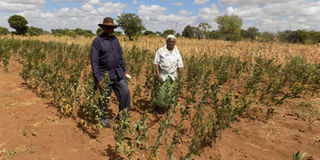How harvesting of rainwater turned around our farm

Samuel Mukonza with his wife in their farm in Makueni. The couple collects rainwater which they use for farming crops. PHOTO | STEPHEN MUTHINI | NMG
What you need to know:
- Zai pits help collect water and use for planting crops in the dry season.
- Locals call them ‘Tumbukiza Technology’ because crops grow inside the pits where water percolates and keeps them green for a longer period after the rains disappear.
- Mukonza, who struggled before he embraced water harvesting technologies, usually harvests some eight bags of green grams every season.
Samuel Mukonza’s evergreen farm in Mbuvo village, Makueni, looks different from the surrounding sun-baked farms.
The farm hosts a lush green crop of pigeon peas and mango trees heavy with ripening fruits, despite the aridity.
The wonder on Mukonza’s farm revolves around how he has managed to harvest rainwater making his crops thrive in the semi-arid region.
Standing at close to 8ft tall, the towering 66-year-old farmer jokingly tells Seeds of Gold that he ‘takes captive’ of every drop of water that enters his farm.
Apart from a giant underground water tank with a capacity of 330 cubic metres, the farm is dotted with tens of small square pits.
The pits, known as Zai and measuring 2 by 2 meters, and are 150cm deep are halfway filled with crop residue or manure and fertiliser and crops planted inside.
Locals call them ‘Tumbukiza Technology’ because crops grow inside the pits where water percolates and keeps them green for a longer period after the rains disappear.
Besides the pits, there are deep terraces cutting across Mukonza’s vast farm. The terraces harvest rainwater from the nearby tarmac road and directs it to the underground tank.
“These pits have enabled us to grow tomatoes, maize, arrow roots, vegetables like sukuma wiki, green grams, pigeon peas and cowpeas,” says Mukonza, noting he learnt the technology two years ago from trainings by the Anglican Development Services Eastern and Alliance for Green Revolution in Africa (Agra).
Urbanus Mutua, an agronomist with the Anglican organisation, says while digging the pits, one should separate top soil with sub-soil.
“The top soil which is more fertile is then mixed with manure and put back into the pit to fill it halfway. Crops are planted in the pit while the sub-soil is placed on the sidelines of the pit,” he explains.
WATER HARVESTING TECHNOLOGIES
He adds that there is no risk of crops soaking in the pits as the water easily drains within a day due to the mixing of top soil with manure but the moisture is retained for long.

Terraces and zai pits for collecting water and planting crops in Mukonza's Makueni farm. The pits are halfway filled with crop residue or manure and fertiliser and crops planted inside. PHOTO | STEPHEN MUTHINI | NMG
Mukonza, a father of seven and his wife have not bought any food during dry spells.
“I have been selling the surplus and have managed to purchase a seven-acre farm which I had initially leased.”
The couple has also diversified into dairy and poultry farming. His farm is often used as a demonstration field for farmers who come to learn from him.
“I also grow fodder which I offer my animals and have sufficient water for cleaning their sheds and for their drinking including during the dry season.”
Mukonza, who struggled before he embraced water harvesting technologies, usually harvests some eight bags of green grams every season.
Together with other 120 members of their group, they bulk the produce and sell together when prices peak at Sh9,000 a bag.
He hopes to make Sh54,000 from the sale of green grams alone this March.
His wife Jemimah does value addition on some of the crops for more profits. She grinds flour from sorghum and green grams, which she packs in bags for sell at the local market.
She further makes chapati, mandazi and porridge from the flour earning up to Sh20,000 a month.





